Google Trends is a helpful tool from Google that provides a lot of useful information for making your website and content better for search engines and online audiences. It can provide valuable insights into popular search topics and help you optimize your content strategy.
It gives you up-to-date information about what people are searching for, shows you related topics and questions, and even breaks down the information into different categories. This helps marketers improve their plans and make their online content work better.
In this guide, we’ll explain everything about Google Trends. You’ll find out what it is, and how it’s different from other tools that help with keywords, and we’ll share methods for using it effectively. This way, you can increase the number of people visiting your website and stay ahead of the game.
Here’s a step-by-step guide on how to use Google Trends for SEO and content marketing:
- Explore trending searches
- Search for specific keywords
- Analyze interest over time
- Explore regional interest
- Compare multiple keywords
- Identify related queries
- Filter by category
- Set time ranges
- Create content around trends
- Optimize existing content
- Monitor changes
- Combine with other tools
- Consider paid trends data
- Evaluate performance
By incorporating Google Trends into your SEO and content marketing strategy, you can stay ahead of the curve and create content that resonates with your target audience.
What is Google Trends?
Google Trends is like a super cool telescope for the internet. Imagine you could see what everyone around the world is curious about at any moment. That’s what Google Trends does. It helps you know what people are searching for on Google right now.
You can discover the hottest topics, check out related things, and see how these interests change over time. It’s like peeking into the internet’s crystal ball to understand what’s buzzing and what people are talking about.
Explore Trending Searches
Exploring trending searches on Google Trends is pretty straightforward. Here’s a step-by-step guide, along with real-world examples:
- Visit Google Trends: Go to the Google Trends website.
- Explore Trending Searches: On the homepage, you’ll find a section called “Trending Searches.” This shows you what people are searching for right now. For example, if you visit the site during a major sports event, you might see terms related to that event in the trending searches.
- Filter by Location and Time: You can customize the trends by selecting a specific location or time range. For instance, if you want to know what people in the United States are searching for, you can choose that location.
- Check Category Insights: Google Trends allows you to filter by categories like Entertainment, Health, Science, and more. If you’re interested in the latest in technology, you can explore trending searches specifically in that category.
Real-world Example: Let’s say it’s the holiday season, and you want to create content related to popular gift ideas. You can use Google Trends to explore trending searches related to “holiday gifts” or “Christmas presents.” The tool might show you specific products, types of gifts, or even emerging trends in gift-giving.
By exploring trending searches, you can stay updated on what’s capturing people’s attention right now and tailor your content to meet current interests and demands.
Search for Specific Keywords
Searching for specific keywords on Google Trends is easy. Here’s how you can do it:
- Go to Google Trends: Open your web browser and go to the Google Trends website.
- Enter Your Keywords: In the search bar at the top, type in the keywords you want to explore. For example, if you’re interested in trends related to “Tata Technologies IPO allotment”, enter that term.
- Explore the Results: Press “Enter” or click on the “Explore” button. Google Trends will show you a graph of the keyword’s popularity over time.
- Refine Your Search: You can further refine your search using filters like location, time range, and category. For instance, you might want to see how the interest in “Tata Technologies IPO allotment” varies between different countries or over the past 12 months.
- Compare Multiple Keywords: If you want to compare the trends of different keywords, separate them with commas in the search bar. For example, you could compare other keywords to see which is more popular.
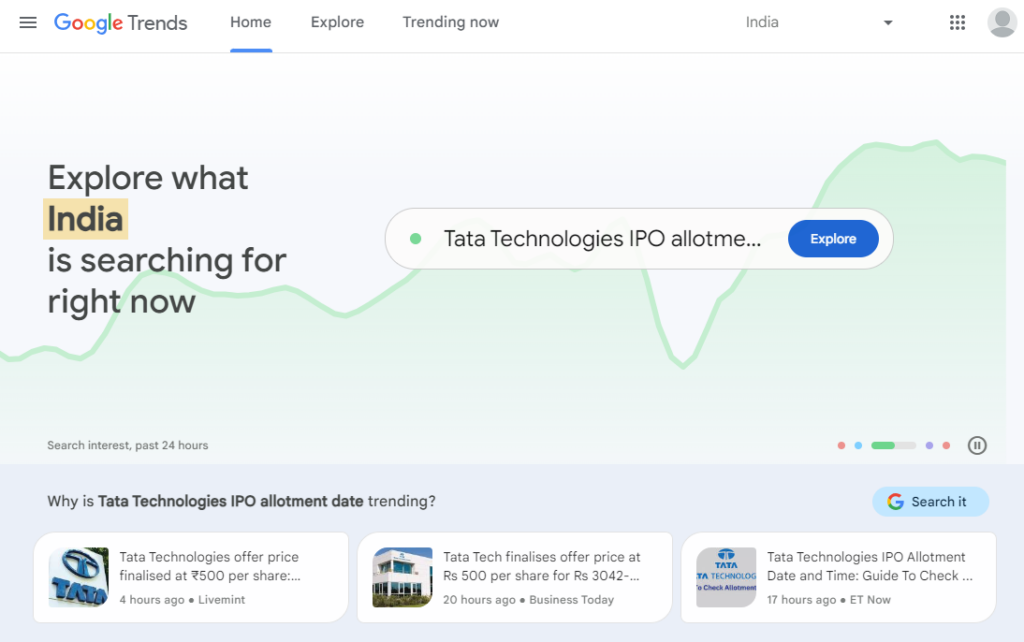
Real-World Example:
Let’s say you run a tech blog, and you’re planning your next article. You’re curious about what people are currently interested in within the tech world. Here’s how you can use Google Trends:
- Visit Google Trends: Go to the Google Trends website.
- Enter Keywords: Type in “smartphones” and “laptops” in the search bar.
- Analyze Trends: See the graph that shows the popularity of these keywords over time. You might notice that interest in “smartphones” is consistently high, but there’s a spike in interest in “laptops” during the back-to-school season.
- Refine Your Search: Use filters to see how these trends vary in different countries or regions. You might discover that “smartphones” are more popular in one country, while “laptops” dominate in another.
By using Google Trends in this way, you can tailor your content to what’s currently buzzing in your niche, ensuring that your articles are timely and relevant to your audience’s interests.
Analyze Keywords’ Interest Over Time
Analyzing keyword interest over time on Google Trends is pretty straightforward. Here’s how you can do it:
- Enter Keywords: Type the keywords you want to analyze in the search bar. For example, let’s use “smartphones.”
- Set Filters (Optional): You can set filters for specific locations, time ranges, and categories if you want more targeted results. For now, let’s keep it general.
- Explore the “Interest Over Time” Graph:
- Below the search bar, you’ll see the “Interest over time” graph. This graph shows the popularity of your keyword over a specified period.
- You can hover over different points to see specific data for particular times.
- Identify Peaks and Valleys:
- Peaks indicate times when interest in your keyword is high.
- Valleys show periods of lower interest.
- Check for Seasonal Trends:
- Look for recurring patterns. Some keywords may have seasonal spikes (for example, “deals” peaking around specific months).
- Compare Multiple Keywords (Optional):
- You can add more keywords to compare how their interests stack up over time. For example, compare “smartphones” and “mobile phone”.
- Explore Related Queries:
- Scroll down to see the “Related queries” section. This shows other terms people often search for alongside your main keyword.
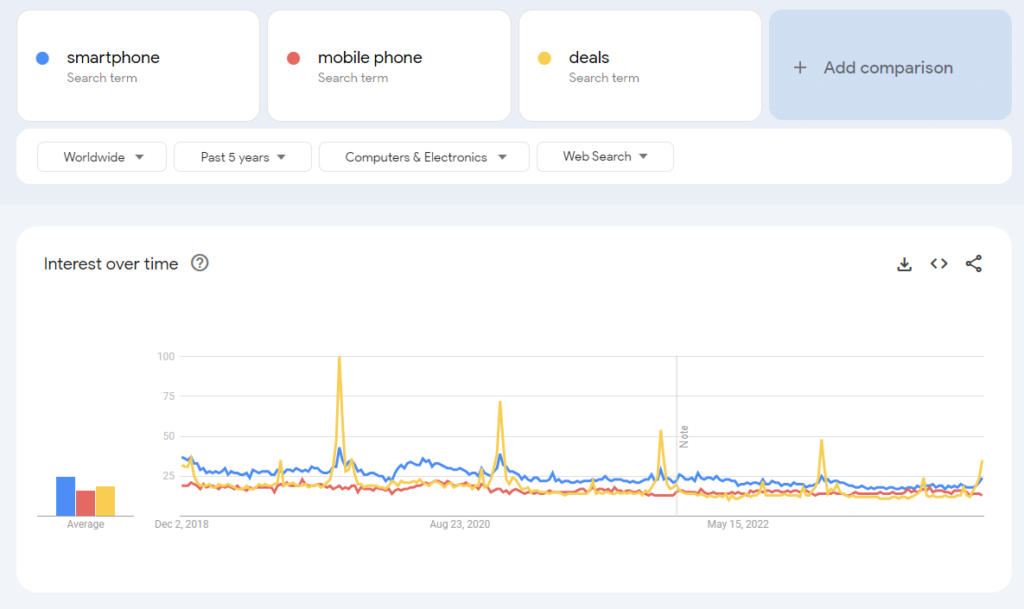
Real-World Example: Let’s say you’re running a tech blog. You use Google Trends to analyze the interest in “smartphones” over the past year. The graph shows a spike in interest around the release of a new flagship phone in September. This information tells you that writing articles or creating content around new phone releases might attract more readers during those peak times.
Remember, Google Trends helps you see when people are most interested in your chosen keywords, allowing you to tailor your content strategy to match these trends.
Explore Regional Interest in Keywords on Google Trends
Exploring regional interest in keywords on Google Trends is like taking a closer look at what specific areas are buzzing about. Here’s a step-by-step guide:
- Enter Your Keywords: Type your keywords into the search bar.
- Adjust Location: Look for the “Location” option below the search bar. Click on it, and you can choose specific countries, states, or cities. For example, if you’re interested in “smartphones,” you might want to see how this term trends in the United States or compare it between California and New York.
- Analyze Results: Check the “Interest by region” section below the search bar. You’ll see a map with colour-coded regions based on the popularity of your keywords. The darker the colour, the higher the interest.
Example: Let’s say you’re a travel blogger interested in the keyword “smartphone”. You want to explore which states in India are currently most excited about smartphones.
- Go to Google Trends: Navigate to Google Trends.
- Enter Keywords: Type “smartphone” into the search bar.
- Adjust Location: Click on “Location” and select “India”
- Analyze Results: Scroll down to the “Interest by region” section. The map will show you which states have the highest interest in beach vacations. Darker colours indicate stronger interest.
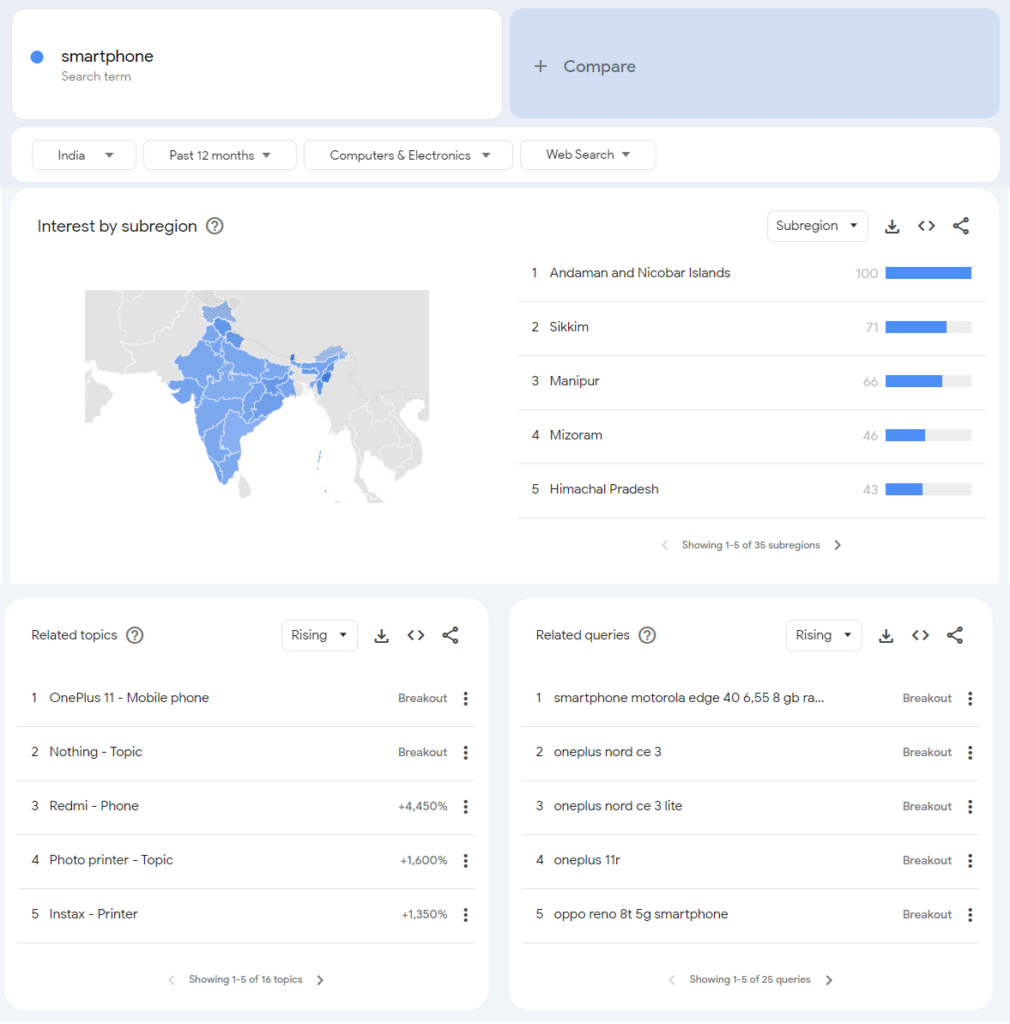
This information can help you tailor your content. If you see Florida has the highest interest, you might create content about the best beaches in Florida. If California is also high, consider writing about the top beach destinations on the West Coast.
Remember, this feature is not just for the U.S. You can explore regional interest globally based on your target audience or market. Adjust the location settings accordingly to gain insights into specific areas relevant to your content or business.
Identify Related or Top Queries On Google Trends
Identifying related queries on Google Trends is pretty straightforward. Here’s a simple guide:
- Enter Your Main Query: In the search bar, type in your main query or topic. This could be a keyword or a phrase related to your interest.
- Check the “Related Queries” Section: Scroll down to find the “Related queries” section. This area shows you other searches that people often make along with your main query.
- Explore Related Topics: Additionally, you can check the “Related Topics” section to see broader subjects related to your main query.
Now, let’s go through a real-world example:
Example keyword: “Smartphones”
- Go to Google Trends: Open Google Trends in your browser.
- Enter “Smartphones” as the Query: Type “Smartphones” into the search bar.
- Explore Related Queries: Scroll down to the “Related queries” section. You might find terms like “Best smartphones,” “Latest mobile phones,” or “Smartphone reviews” as related queries. These are topics closely associated with the main query.
- Check Related Topics: In the “Related topics” section, you may discover broader themes like “Mobile technology” or “Cell phones.” These are overarching subjects connected to the main query.
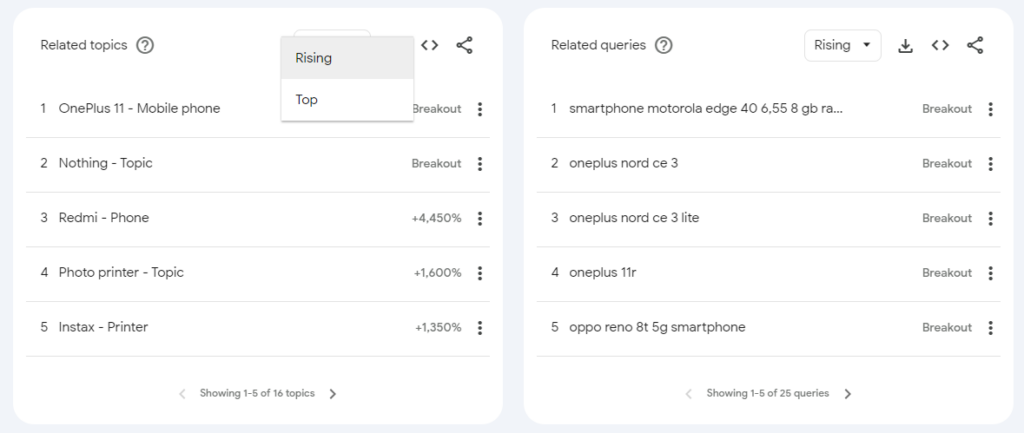
By identifying related queries, you gain insights into what people are searching for in connection with your main topic. This information can be gold for creating content that aligns with user interests and expands the reach of your SEO strategy.
What Sets Apart Google Trends Data from Keyword Search Volumes?
Google Trends data and keyword search volumes both provide insights into what people are searching for, but they differ in their focus and application.
Google Trends Data:
- Temporal Insights: Google Trends shows you how the popularity of a search term changes over time. It can reveal if interest is increasing, decreasing, or staying consistent.Example: If you are interested in the term “beach vacations,” Google Trends might show increased interest during the summer months and a decrease during the winter.
- Comparative Analysis: You can compare the relative popularity of multiple search terms. This helps in understanding which term is more widely searched.Example: Comparing “organic skincare” and “natural skincare” might reveal that “organic skincare” is currently more popular.
- Regional Variations: Google Trends provides information on where a search term is most popular geographically.Example: If you’re targeting a regional audience, you can use this data to tailor your content. If “hiking trails” is more popular in a specific state, you might focus your content efforts there.
Keyword Search Volumes:
- Quantitative Metrics: Keyword search volumes provide specific numbers indicating how many times a particular term is searched on average. Example: You might find that “best smartphones” is searched 100,000 times per month.
- Ad Campaign Planning: Keyword search volumes are often used in the planning of online advertising campaigns, helping advertisers understand the potential reach of their ads. Example: If you’re running a Google Ads campaign for “tech gadgets,” knowing the search volume helps you estimate how many people might see your ad.
- Specific Intent: Keyword search volumes can indicate the level of intent behind a search. High search volumes may suggest a more generic or informational query, while lower volumes might indicate a more specific, niche interest. Example: “How to tie a tie” might have a higher search volume as it’s a common query, while “How to tie a bowtie” might have a lower volume but a more specific audience.
Real-world Example:
Let’s say you’re running a travel blog. Google Trends might show that interest in “staycations” has been increasing steadily. This could prompt you to create content around staycation ideas, even if the search volume for this term is lower than a more general term like “vacation destinations.”
In contrast, if you’re running Google Ads for your travel agency, you’d likely rely on keyword search volumes to choose high-traffic terms that align with your services.
In summary, Google Trends is excellent for understanding trends, patterns, and regional interests, while keyword search volumes provide precise quantitative data useful for advertising and specific content optimization. Combining insights from both can enhance your overall SEO and marketing strategy.
How To Find Trending Searches?
Finding trending items on Google Trends is a straightforward process. Here’s a step-by-step guide:
- Explore Trending Searches: On the Google Trends homepage, you’ll find a section called “Trending Now.” This area displays a list of topics that are currently popular.
- Check Top Charts: Navigate to the “Daily search trends” or “Realtime search trends” section. Here, you can see the top trending searches across various categories, including Technology, Entertainment, Health, and more.
- Use the Explore Bar: If you have specific interests, use the Explore bar at the top of the page. Enter a keyword or topic you’re curious about, and Google Trends will show you the current interest and related queries.
- Filter by Categories and Countries: To narrow down your search, use the categories and countries filters. You can focus on a specific industry or see what’s trending in a particular region.
- Adjust Time Range: You can customize the time range to see trends over the past hour, day, week, month, or even year. This helps you identify short-term spikes or long-term patterns.
- Explore Related Queries: When you search for a specific topic, scroll down to the “Related queries” section. Here, you’ll find additional related terms that people are searching for, giving you more insights into the trend.
- Subscribe to Email Alerts: If you want to stay updated on specific topics, consider subscribing to email alerts. Google Trends will send you notifications when there’s a significant increase in search interest for your chosen topics.
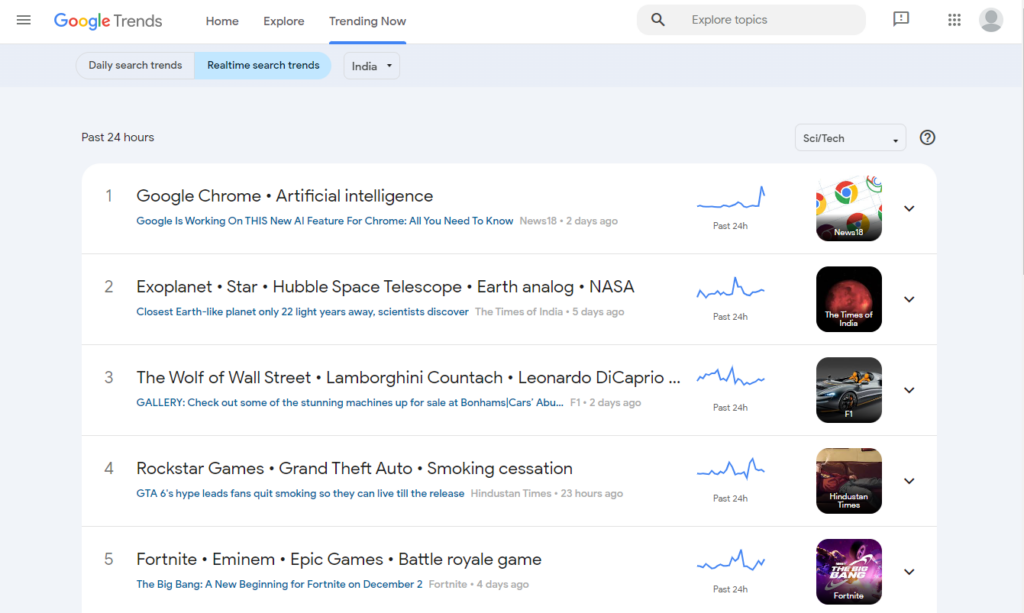
Real-world Example:
Let’s say you’re interested in discovering trending items related to fitness:
- Go to Google Trends.
- Check the “Trending Searches” section to see if any fitness-related topics are currently popular.
- Explore the “Top Charts” under the Fitness category to find the most popular fitness searches.
- Use the explore bar to enter specific fitness-related keywords and see their current trend.
- Filter by country if you want to focus on a particular region.
By following these steps, you can identify trending items on Google Trends and stay informed about what people are searching for in real time. This information can be valuable for content creation, marketing, and staying ahead of the latest trends in your industry or interests.